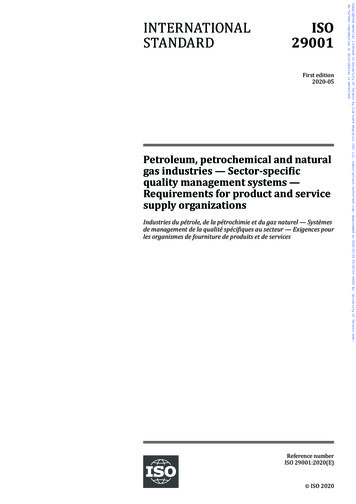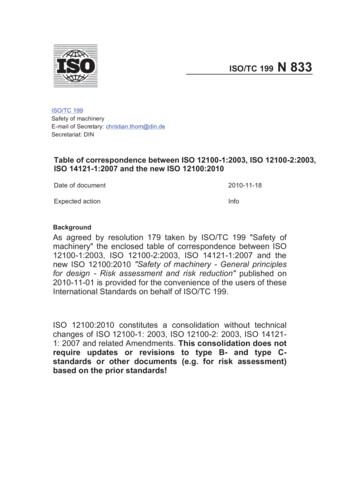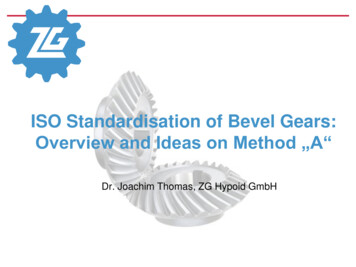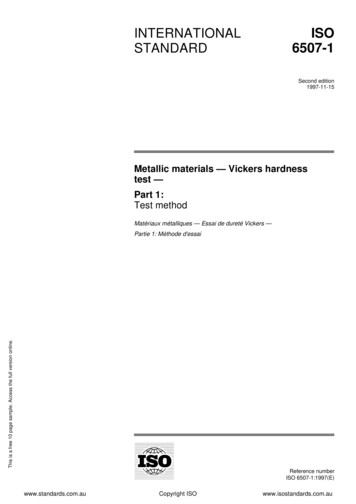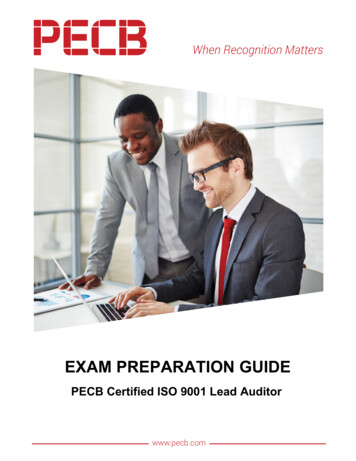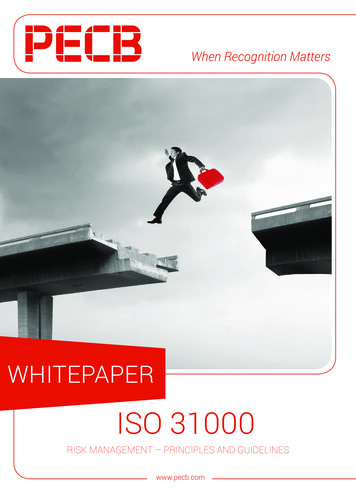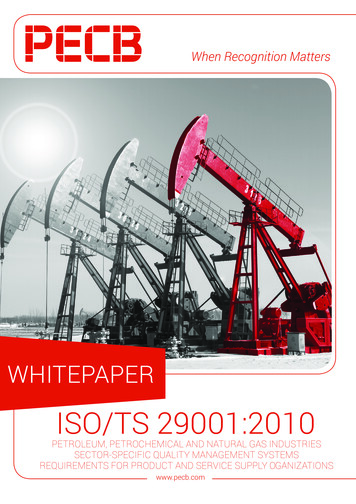
Transcription
When Recognition MattersWHITEPAPER ISO/TS 29001:2010PETROLEUM, PETROCHEMICAL AND NATURAL GAS INDUSTRIESSECTOR-SPECIFIC QUALITY MANAGEMENT SYSTEMSREQUIREMENTS FOR PRODUCT AND SERVICE SUPPLY OGANIZATIONSwww.pecb.com
CONTENT3Introduction4An Overview of ISO/TS 29001:20104Key Clauses of ISO/TS 29001:20106Link of ISO/TS 29001 with other Quality Management Methods and Techniques6ISO/TS 29001 Opposed to ISO 90017What are the Benefits?7Oil and Gas Quality Management Principles8Why is PECB a Worthy Choice?10Steps for Obtaining a PECB CertificationPRINCIPAL AUTHORSEric LACHAPELLE, PECBMustafe BISLIMI, PECBBardha AJVAZI, PECB2ISO/TS 29001:2010 // PETROLEUM, PETROCHEMICAL AND NATURAL GAS INDUSTRIES
INTRODUCTIONEver since the first oil-well was drilled in 1859, oil production has become a continuously complex anddetailed process.The ISO/TS 29001:2010 is quality management system that provides requirements for the design,development, production, installation, and service of products for the petroleum, petrochemical, and naturalgas industries. This standard is designed to help these organizations ensure that they meet all requirementsof customers and stakeholders.The ISO/TS 29001:2010 standard is based on ISO 9001, and includes supplementary requirementshighlighting defect prevention and the reduction of deviation and waste from service providers.The ISO/TS 29001:2010 was developed as the result of cooperation between the American PetroleumInstitute (API) and ISO technical committee ISO/TC 67.The ISO/TS 29001:2010 is applicable to the following organizations: Organizations involved in exploration, production,pipelines and transportation, and refining of petroleumand natural gas products; Organizations involved in the design, manufacture,installation, service and repair of equipment used in theexploration, production, transportation and refining ofpetroleum and natural gas products; and Organizations that provide technical, operational andsupport services to the various industry sectors identifiedabove.Ed Durante, project leader of the ISO/TC67 working group, declared that:“ISO/TS 29001 has now been acceptedas the baseline requirement for qualitymanagement systems in the explorationand production sector of the petroleumand natural gas industry.”This Technical Specification is intended to avoid multiple certification audits and provide a commonapproach to a quality management system for the petroleum, petrochemical and natural gas industries.ISO/TS 29001:2010 // PETROLEUM, PETROCHEMICAL AND NATURAL GAS INDUSTRIES3
An Overview of ISO/TS 29001:2010ISO/TS 29001 specifies technical specification requirements for a quality management system in an oiland gas industry where an organization needs to demonstrate its ability to consistently provide productsand services that meet customer and applicable statutory and regulatory requirements. Its aim is toenhance customer satisfaction through the effective application of the system, including processes forcontinual improvement of the system and assurance of conformity to customer and applicable statutoryand regulatory requirements.All requirements of ISO/TS 29001 are generic and are intended to be applicable to all organizations,regardless of type, size and product providedQuality standardization for petroleum evolves with ISO/TS 29001 by adding: Greater emphasis on setting the objectives, monitoring performance and metrics;Clearer expectations on management;More careful planning for and preparing the resources needed for ensuring quality in oil and gas industry.ISO/TS 29001 applies to all types and sizes of organizations that wish to: Establish, implement, maintain and improve a quality management system in an oil and gas industry;Assure conformity with the organization’s stated quality policy;Demonstrate conformity to others;Seek certification/registration of its quality management system by an accredited third party certificationbody; andMake a self-determination and self-declaration of conformity with this International Standard.KEY CLAUSES OF ISO/TS 29001:2010ISO/TS 29001 is organized into the following main clauses:Clause 4: Quality management systemClause 5: Management responsibilityClause 6: Resource managementClause 7: Product realizationClause 8: Measurement, analysis and improvementEach of these key activities is overviewed below:Clause 4: Quality Management SystemThe organization shall continually improve their quality management system by complying with thefollowing requirements of this International Standard. They shall: 4Determine the sequence and interaction of processes to ensure that both the operation and control ofthese processes are effective;Provide necessary resources and information to support the operation, monitoring, measuring andanalyzing of these processes; andImplement necessary actions to achieve planned results and continual improvement of these processes.ISO/TS 29001:2010 // PETROLEUM, PETROCHEMICAL AND NATURAL GAS INDUSTRIES
Clause 5: Management ResponsibilityIt is the responsibility of top management to demonstrate their ongoing commitment to the development andimplementation of the quality management system of oil and gas, and continually improve its effectiveness by: Communicating to the organization the importance of meeting customer, statutory and regulatoryrequirements;Establishing the quality policy and ensuring that quality objectives are established;Conducting management reviews; andEnsuring the availability of resources.Clause 6: Resource ManagementThe customary management of an effective quality management system relies on using the appropriateresources for each task. These resources include competent staff with relevant (and demonstrable) trainingand supporting services, awareness and communication.To achieve conformity to product or service requirements, it is important to provide and maintain anappropriate infrastructure.The work environment is also another critical factor, which must be managed by the organization in orderto achieve conformity to product or service requirements.Clause 7: Product RealizationThe processes that relate to product realization are: Planning of product realization: During this stage the organization must plan and develop all processesnecessary for product realization. Customer-related processes: It is important to manage processes that relate to customers, in order toensure that the organization is determining and meeting their requirements. Design and development: The design and development processes of the final product must include thefollowing: Design and development planning,Inputs,Outputs,Review,Verification, and validation and control of design and development changes. Purchasing: It is important for the organization to ensure that purchased products conform to specifiedpurchase requirements. Production and service provision: The processes that associate with the production and service provision are: Control and validation of production and service provision,Identification and traceability,Customer property and preservation of product. Control of monitoring and measuring equipment: The organization is responsible for determining therequirements for monitoring and measuring equipment needed to provide evidence of conformity ofproduct. The results from the conducted measurements and monitoring activities shall be recorded andmaintained.ISO/TS 29001:2010 // PETROLEUM, PETROCHEMICAL AND NATURAL GAS INDUSTRIES5
Clause 8: Measurement, Analysis and ImprovementOnce the quality management system is implemented, ISO/TS 29001 requires permanent monitoring,measurement, analysis and improvement to: Demonstrate conformity to the product;Ensure conformity of the quality management systemin an oil and gas industry; andContinually improve the effectiveness of the qualitymanagement system.Continual improvement can be definedas all the actions taken throughout theorganization to increase effectiveness(reaching objectives) and efficiency (anoptimal cost/benefit ration) of qualityprocesses to bring increased benefits tothe organization and its stakeholders.An organization can continually improve the effectivenessof its management system through the use of the qualitypolicy, objectives, audit results, analysis of data, correctiveand preventive actions.LINK OF ISO/TS 29001 WITH OTHERQUALITY MANAGEMENT METHODS ANDTECHNIQUESApart from the ISO/TS 29001, there are other methods and techniques related to quality managementthat are used to enhance quality and productivity in organizations, such as:Quality CricleTotal QualityManagement(TQM)Six SigmaLeanKaizenBalanced Scorecard(BSC)Eight DisiplinesProblem Sloving(8D)Just-in-Time(JiT)Total ProductiveMaintenanceToyota WayISO/TS 29001 OPPOSED TO ISO 9001ISO/TS 29001 and ISO 9001 are both quality management standards designed to complement eachother, however can also be used independently.ISO/TS 29001 was developed as a result of the need for a more rigorous sector-specific quality management system that provides additional assurance relating the processes of product and service suppliers.The improvements to the basic ISO 9001:2000 are necessary and beneficial to all members of an oil andgas industry.6ISO/TS 29001:2010 // PETROLEUM, PETROCHEMICAL AND NATURAL GAS INDUSTRIES
What are the Benefits?Gradually, organizations within the supply chain will need certification against this standard in order to secure their contracts.Commitment to health and safety - Oil and gas industries deal with hazardous fluids and gases through avariety of processes, which makes the safety of personnel and public of primary importance.Protection - The environment needs a high level of protection to assure business continuity and operationalintegrity.Integration - ISO/TS 29001 incorporates the requirements of ISO 9001 and includes detailed, sector-specificrequirements for design, development, production, installation and service of products.The monitoring of performance and continual improvement is based on the principles of ISO 9001.Better understanding of theorganizationRegulatory complianceCost reductionConfidence of clientContract complianceCompetitive advantageIncreased efficiencyLegal complianceRespect of theinterested partiesThe adoption of an effective quality management process within an organization will have many benefitsin a number of areas, such as:1.2.3.4.5.6.7.8.9.10.Increase of efficiency;Increase in revenue;Increase of employee morale;International recognition;Establishment of a factual approach to decision making;Strengthen supplier relationships;Support the proficiency of documentation;Build consistency;Increase customer satisfaction; andImprove processes.Oil and Gas Quality Management PrinciplesSimilar to ISO 9001, ISO/TC 29001 is also based on the eight quality management principles that can beused by the top management to lead the organization towards improved gement andcompetence of peopleEvidence-basedDecision MakingProcessapproachRelationshipManagementISO/TS 29001:2010 // PETROLEUM, PETROCHEMICAL AND NATURAL GAS INDUSTRIES7
Customer focus: Organizations depend on their customers and therefore should understand currentand future customer needs, should meet customer requirements and strive to exceed customerexpectations. Leadership: Leaders establish unity of purpose and direction of the organization. They should createand maintain the internal environment in which people can become fully involved in achieving the organization's objectives. Engagement and competence of people: People at all levels are the essence of an organization and theirfull involvement enables their abilities to be used for the organization's benefit. Process approach: A desired result is achieved more efficiently when activities and related resourcesare managed as a process. Improvement:: Continual improvement of the organization's overall performance should be a permanent objective of the organization. Evidence-based decision making: Effective decisions are based on the analysis of data and Relationship management: An organization and its suppliers are interdependent and a mutually beneficial relationship enhances the ability of both to create value.WHY IS PECB A WORTHY CHOICE?Implementation of a QMS in an Oil and Gas Industry with IMS2 MethodologyConsidering the well documented benefits of implementing a Quality Management System based on ISO/TC 29001, makes the proposal easier to decide on.Most companies now realize that it is not sufficient to implement a generic, “one size fits all” quality plan.For an effective response, with respect to maintaining the quality management system, such a plan mustbe customized to fit to a company. A more difficult task is the compilation of an implementation plan thatbalances the requirements of the standard, the business needs and the certification deadline.There is no single blueprint for implementing ISO/TC 29001 that will work for every company, but there aresome common steps that will allow you to balance the frequent conflicting requirements and prepare youfor a successful certification audit.PECB has developed a methodology (please see example below) for implementing a management system; the “Integrated Implementation Methodology for Management Systems and Standards (IMS2)”, and it isbased on applicable best practices. This methodology is based on the guidelines of ISO standards and alsomeets the requirements of ISO/TC 29001.8ISO/TS 29001:2010 // PETROLEUM, PETROCHEMICAL AND NATURAL GAS INDUSTRIES
1. Plan2. Do3. Check1.1 Initiating the QMS2.1 Organizational Structure1.2 Understanding the Organization2.2 Document Management1.3 Analyze the Existing System2.3 Design of Controls and Procedures1.4 Leadership and Project Approval2.4 Communication1.5 Scope2.5 Awareness and Training1.6 Safety Policy2.6 Product Realization4. Act3.1 Monitoring, Measurement,Analysis and Evaluation4.1 Treatment of Non-conformities4.2 Improvement3.2 Internal Audit3.3 Management Review2.7 Operations ManagementIMS2 is based on the PDCA cycle divided into four phases: Plan, Do, Check and Act. Each phase has between2 and 8 steps for a total of 18 steps. In turn, these steps are divided into 101 activities and tasks. This‘Practical Guide’ considers the key phases in your implementation project from start to finish and suggeststhe appropriate ‘best practice’ for each one, while directing your to further helpful resources as you embarkon your ISO/TC 29001 lanDoQMSProjectsCheckActThe sequence of steps can be changed (inversion, merge). For example, the implementation of themanagement procedure for documented information can be done before the understanding of theorganization. Many processes are iterative because of the need for progressive development throughoutthe implementation project; for example, communication and training.By following a structured and effective methodology, an organization can be sure it covers all minimumrequirements for the implementation of a management system. Whatever methodology used, theorganization must adapt it to its particular context (requirements, size of the organization, scope, objectives,etc.) and not apply it like a cookbook.ISO/TS 29001:2010 // PETROLEUM, PETROCHEMICAL AND NATURAL GAS INDUSTRIES9
STEPS FOR OBTAINING A PECBCERTIFICATIONFor organizations:For individuals:1. Implement the management system1. Participate in the training course2. Perform internal audit and reviews2. Register for the certification exam3. Select preferred certification body3. Sit for the certification exam4. Perform a pre-assessment audit (optional)4. Apply for the certification scheme upon successful completion5. Perform the stage 1 audit5. Obtain certification6. Perform the stage 2 audit (on-site)7. Perform a follow-up audit (optional)8. Register the certification9. Assure continual improvement by conductingsurveillance auditsFor further details relating the types of trainings and certifications that PECB offers, please visit ourwebsite: www.pecb.com10ISO/TS 29001:2010 // PETROLEUM, PETROCHEMICAL AND NATURAL GAS INDUSTRIES
1-844-426-7322customer@pecb.comCustomer Servicewww.pecb.com
ISO/TS 29001 OPPOSED TO ISO 9001 ISO/TS 29001 and ISO 9001 are both quality management standards designed to complement each other, however can also be used independently. ISO/TS 29001 was developed as a result of the


